


RAF Battle of Britain Hawker Hurricane
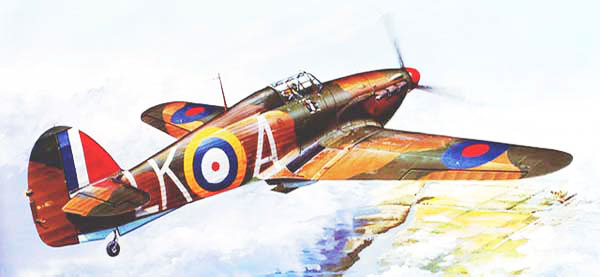
Compared to the Spitfire, the Hurricane was the unsung hero, the humpbacked underdog, of the Battle of Britain. We've spent a lot of effort on this model to get it as accurate as possible. Although outshone by the legendary Spitfire in terms of grace and
speed, the Hurricane was the Hawker Hurricane in the RAF's front-line
aircraft in the Battle of Britain. A sturdy, reliable fighter,
the 'Hurry' is still remembered with affection by those who flew
it...
Hawker Hurricane
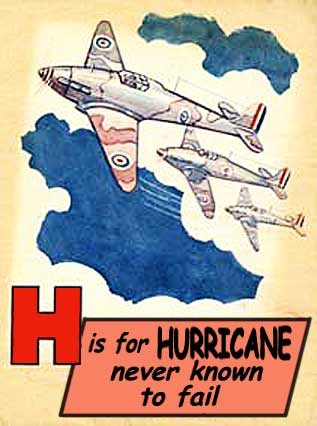
Although outshone by the legendary Spitfire in terms of grace and speed, the Hurricane was the RAF's front-line aircraft in the Battle of Britain. A sturdy, reliable, fighter, the 'Hurry' is still remembered with affection by those who flew it. The Hurricane acquired its name in 1936, some three years after Sidney Camm, chief designer for the Hawker Aircraft Company, began discussing a monoplane successor to his biplane Fury.
Camm, awarded a knighthood in 1953 in recognition of his services to aviation, at first envisaged his Fury Monoplane' as a purely private venture; the RAF was still reliant on his biplane and considered monoplanes too new and risky. But with Hitler now in power and Germany known to be rearming, in 1934 the growing international tension prompted the issue of two new Air Ministry specifications for what would become the Hurricane and the Spitfire.
Camm's monoplane had already spent many long months on the drawing board, and his design was now quick to take off. The prototype first flew in November 1935, by which time its original Goshawk engine had been swapped for the PV.12, another Rolls-Royce engine better known as the Merlin. Despite being bigger and heavier, the Merlin added over 100mph to the Hurricane's speed.
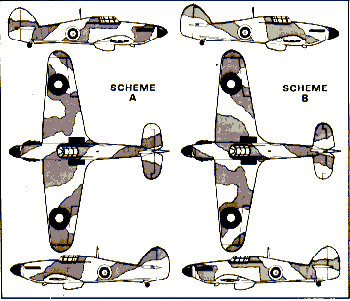 The early version's traditional fabric-covered metal
frame, with wooden formers, gave it great strength. The thick
wing not only produced a rate of climb higher than almost any
aircraft of its time, but could also house eight .303" (7.70mm)
machine guns, each with 500 rounds of ammunition, all firing outside
the propeller arc. The retractable undercarriage was robust enough
to withstand repeated bumping on grass airfields, and - due to
the wide, split, trailing-edge flaps - landing speeds were little
more than 57mph.
The early version's traditional fabric-covered metal
frame, with wooden formers, gave it great strength. The thick
wing not only produced a rate of climb higher than almost any
aircraft of its time, but could also house eight .303" (7.70mm)
machine guns, each with 500 rounds of ammunition, all firing outside
the propeller arc. The retractable undercarriage was robust enough
to withstand repeated bumping on grass airfields, and - due to
the wide, split, trailing-edge flaps - landing speeds were little
more than 57mph.
In the air, although slightly heavy, the prototype Hurricane proved to have excellent flying qualities:positive to handle, with a tight turning radius and providing a stable gun platform. So confident were they of its potential that, even before the official order came in, Hawker set their assembly line in motion and the first production model took to the skies in October 1937. But it was not until May 1938 that the Hurricane attracted public attention, when Flight Lieutenant John Gillan flew from Edinburgh to London in less than an hour - albeit with the aid of a tailwind.
Refinements made to the Hurricane by the spring of 1940 included the fitting of a three-blade, constant speed propeller; an armour-plated bulkhead and bullet-proof windscreen; and metal-skinned wings (though the fuselage retained its fabric covering).
Hawker chief designer Sydney Camm's first submissions were rejected by the Air Ministry so he began work on what he called a "Fury Mono plane," referring to the Hawker Fury, a highly successful biplane of his design. There were economies to this approach, in that existing Hawker tooling could be used. Camm was also keeping tabs on Rolls-Royce's progress with the PV-12 engine. The prototype Hurricane first flew in the summer of 1936.
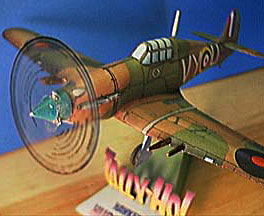 Just as the open girder work of Britain's radar towers made
them immune to virtually anything but a direct bomb blast, the
Hurricane's fuselage was able to withstand a tremendous amount
of punishment from Bf-109 cannon shells exploding inside its structure.
Like the Fury's the Hurricane's fuselage was made of steel tubing,
around which was built a wooden frame of stringers and formers
covered in fabric. This method of construction gave the Hurricane
a distinct advantage over the Spitfire, whose stressed skin could
better be compared with an eggshell.
Just as the open girder work of Britain's radar towers made
them immune to virtually anything but a direct bomb blast, the
Hurricane's fuselage was able to withstand a tremendous amount
of punishment from Bf-109 cannon shells exploding inside its structure.
Like the Fury's the Hurricane's fuselage was made of steel tubing,
around which was built a wooden frame of stringers and formers
covered in fabric. This method of construction gave the Hurricane
a distinct advantage over the Spitfire, whose stressed skin could
better be compared with an eggshell.
While the Spit's eight Browning machine guns were widely spaced across its span, Camm put the Hurricane's punch in tight groups of four each side at little more than a quarter span. Inward-retracting undercarriage provided a wide, stable track for good landing qualities.
Although generally outclassed by the Bf-1O9 in the right hands the Hurricane could be lethal: Sqn. Ldr. Tom Gleave shot down four Bf-109s in a single engagement with his Hurricane.
The eight Colt/Browning machine guns of the' Spitfire and Hurricane each carried 300 rounds fired at a rate of 1,200 rounds per minute and at a muzzle of 2, 600 feet per second; each projectile weighed about a third of an ounce.When the pilots saw tracers coming out of their guns they knew they were into the last 20 or so bullets.
The first Hawker monoplane fighter, the Hurricane, is indissolubly associated with its designer, Sydney Camm. Its evolution began in 1933 as a monoplane development of the Fury biplane fighter, with a fixed landing gear and a Rolls Royce Goshawk. Early in 1934. significant improvements included a fully retractable main undercarriage, eight wing mounted 0.303in machine-guns and the use of the new Rolls Royce PV-12 - the Merlin.
To Specification P36/34, Hawker completed an unarmed' prototype (K5083), powered by a 990hp Merlin C, which flew on 6 November 1935. In March 1936, without an official order. Hawker confidently began to prepare for production of 1,000, foresight emphasized during the Battle of Britain. Their confidence was justified:
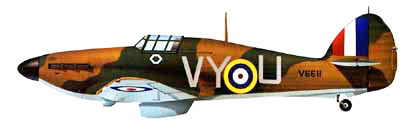 Three months later the Air Ministry placed an initial order
for 600 Mk Is. Delivery began to No Ill Sqdn, in October 1937,
delayed slightly by the decision to use the Merlin II. On 3 September
1939 there were 315 on the fully operational strength of 14 RAF
squadrons, plus 107 in reserve. Total orders stood at 3,500 of
which nearly 500 had been completed. Mk I production by Hawker
and Gloster factories in the UK and the Canadian Car and Foundry
Co (160), totaled 3,934. Canadian-built machines were later redesignated
Mk X. The Hurricane became operational with the Advanced Air Striking
Force in France at the outset of World -War 2, and outnumbered
the Spitfire by about two to one in the Battle of Britain in August-October
1940.
Three months later the Air Ministry placed an initial order
for 600 Mk Is. Delivery began to No Ill Sqdn, in October 1937,
delayed slightly by the decision to use the Merlin II. On 3 September
1939 there were 315 on the fully operational strength of 14 RAF
squadrons, plus 107 in reserve. Total orders stood at 3,500 of
which nearly 500 had been completed. Mk I production by Hawker
and Gloster factories in the UK and the Canadian Car and Foundry
Co (160), totaled 3,934. Canadian-built machines were later redesignated
Mk X. The Hurricane became operational with the Advanced Air Striking
Force in France at the outset of World -War 2, and outnumbered
the Spitfire by about two to one in the Battle of Britain in August-October
1940.
During the second half of 1940 the Mk I appeared in the Middle East, following Italy's entry into the war; these (and later Hurricanes in North Africa) had a Vokes sand filter beneath the nose. In 1942, Hurricanes appeared in Singapore, the Netherlands East Indies and Burma, operating also in the fighter-bomber role. On II June 1940, the prototype Mk II flew with a I, lS3hp supercharged Merlin XX. Early production aircraft, with eight machine-guns, were designated Mk IIA and Mk IIB with 12 machine-guns; the Mk IIC had four 20mm cannon. The Hurricane was becoming outclassed as a fighter and in 1942 was increasingly used for ground-attack. Several Mk lICs were equipped with under wing RP's.
The anti-tank Mk lID had two 40mm under wing cannon and two Browning's in the wings. The last British production model, the ground-attack Mk IV, had various weapon arrangements and a l,620hp Merlin 24 or 27. The Sea Hurricane, with catapult spools and (except for the first 50 Mk lAs) an arrester hook, appeared in 1941 as an interim step to protect convoys, carded aboard CAM ships (Catapult Aircraft Merchantmen). Hurricane conversion resulted in Sea Hurricanes Mk's IA, lB. IC and XIIA. The Mk IIC had a 1,460hp Merlin XX and full FAA radio and other equipment, but no catapult spools. About 800 Sea Hurricanes were built or converted. UK Hurricane production totaled 13,080 by Hawker, Gloster and Austin Motors; the Canadian Car and Foundry Co built a total of 1,451 Mk's X, XML, XII and XIIA, with Packard-Merlins; overall production totaled 14,333. The Soviet Air Force was allocated 2,952 Hurricanes during early war years, although many were lost en route.
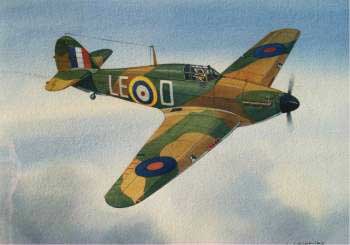 |
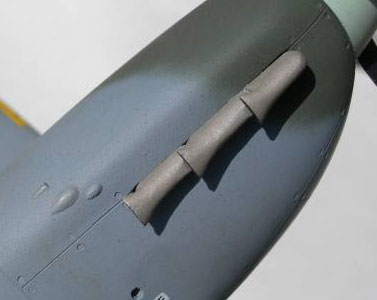 |
The development of the RAF's first monoplane fighter, not counting the RFC's excellent Bristol M-lC of 1917, began in 1933 with the projected Fury Monoplane. This was intended as a four-gun, fixed-landing gear single-wing conversion of the Hawker Fury biplane to be powered by a 660-hp steam-cooled Goshawk engine. Anticipation of the Rolls-Royce PV.12 (later named Merlin) engine caused the Fury conversion to be abandoned, and a new 'Interceptor Monoplane' was planned to meet a revised specification for a four-gun fighter.
Hawker were given the go-ahead for construction of a prototype in February 1935, but by the time the prototype flew in November that year, British licence production of the Browning machine-gun in 0.303-in (7.7-mrn) caliber had been agreed, and the design was further revised to accommodate eight in the wings.
Trials in early 1936 showed a top speed of 3l5mph, and with minor revisions to the controls, landing gear and sliding canopy, 600 production aircraft were ordered in July 1936, the same month that the name Hurricane was bestowed. First deliveries were to No 1 11 Squadron at the end of 1937, and Nos 3 and 56 Squadrons were equipped in 1938. This was entirely because in January 1936, long before the Air Ministry had even hinted at an order, the Hawker Siddeley board had tooled up to make 1000 at Kingston and a new factory at Langley, near Slough.
The decision to adopt the eight-gun armament led to the development of an all-metal stressed-skin wing as early is 1935, but production aircraft delivered before the autumn of 1939 were fitted with the traditional fabric-covered wing. Meanwhile, trials had also been carried out with variable-pitch propellers, which offered much improved take-off and climb performance, and Rotol variable-pitch models 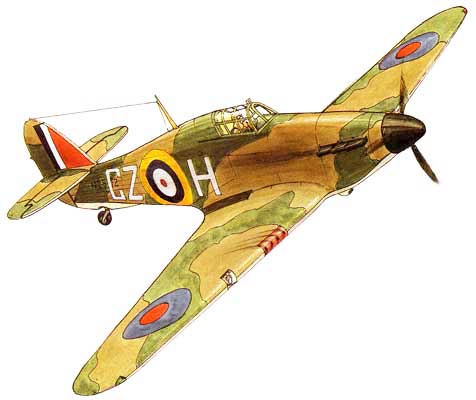 became standard in 1940.
became standard in 1940.
The installation of the 1260-hp Merlin XX engine was the basic distinguishing feature of the Mk II, a converted Mk I flying for the first time with this powerplant in June 1940. New wings with different armament options resulted in a number of sub-series.
The Canadian Car and Foundry company began building Hurricane Is in 1939, and remaining designations covered CCF Hurricanes using Packard-built Merlin 28 or 29 engines. The Mk X and XI corresponded to the IIB, the latter having Canadian equipment.
Total Hurricane production amounted to 14233, the majority by Hawker but including2750, principally Mk Is, supplied by Gloster and l45l built by CCF. The only other firms to build the fighter were Avions Fairey in Belgium, who contributed two of the above total, and Rogo Zarski in Yugoslavia, who built another handful to back up 24 supplied by Britain. Although most exports, which included orders from Turkey, Poland and Iraq, were curtailed by the war, over 100 found their way to overseas customers, and there were postwar sales to Portugal and Iran, included in which were various tandem dual trainers.
This bare summary of Hurricane development and production gives little hint of the type's astonishing versatility. In its original role of interceptor it saw heavy fighting in Norway and France in 1940, before forming the mainstay of Fighter Command during the Battle of Britain, in which no fewer than 1715 examples took part, outnumbering the combined total of all other RAF aircraft, and claiming nearly four-fifths of the 1792 German aircraft destroyed.
It continued to serve in the home-defense role when the Luftwaffe switched to night raids, at the same time expanding its sphere of operations to the Mediterranean, North Africa and the Middle East during 1940, and to the Far East in 1941. In August 1941, the first of an eventual total of 2952 Mks II and IV were dispatched to the Soviet Union. Hurricanes generally delivered their various ordnance loads to telling effect in all their many theatres of operations. They proved particularly valuable in Burma and also carried out second-line tasks.
Finally, not the least of the Hurricane's contributions to Allied victory came at sea. Surplus Mk Is were fitted with catapult spools for use aboard Catapult Armed Merchantmen for convoy protection as Sea Hurricane IAs, from early 1941. Thereafter arrester hooks were added to enable Sea Hurricanes to operate from aircraft carriers.
Specifications for the Hawker Hurricane
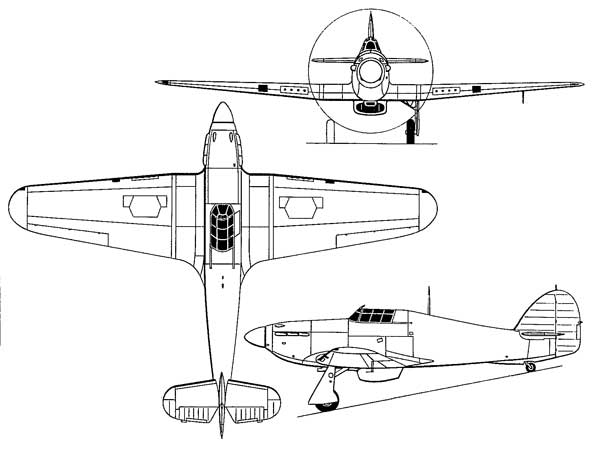 |
Length: 31 ft 5in Performance Armament |
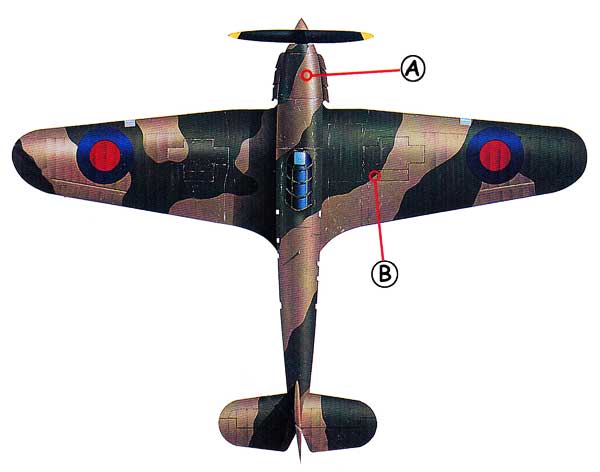 |
|
| A: Power was provided by Rolls-Royce Merlin II or III series engines. | B: Fuel was stored in the wing center section and a fuselage gravity feed tank. The wing was metal covered, with fabric used only on the ailerons. |
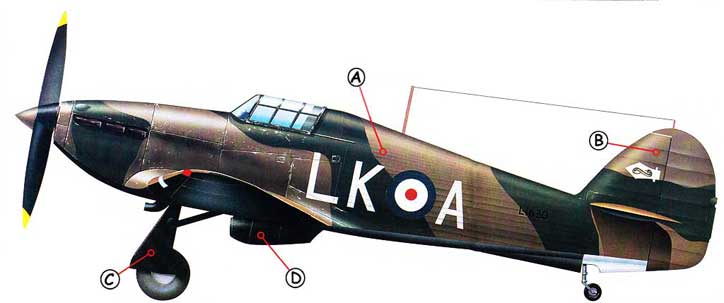 |
|||
| A: Fuselage construction consisted of square-ended metal tubing connected with hollow rivets. The aft fuselage was fabric covered, but the forward section was metal covered. | B: The rounded tailfin and large rudder gave the Hurricane excellent agility, which was vital during dogfights. | C: The Hurricane's wide-track undercarriage was very stable, much more so than that of the Spitfire or Bf 109. This allowed the Hurricane to operate from rough grass airfields. | D: The ducted radiator was fitted under the fuselage. The main oil tank was fitted in the leading edge of the wing on the port side. |
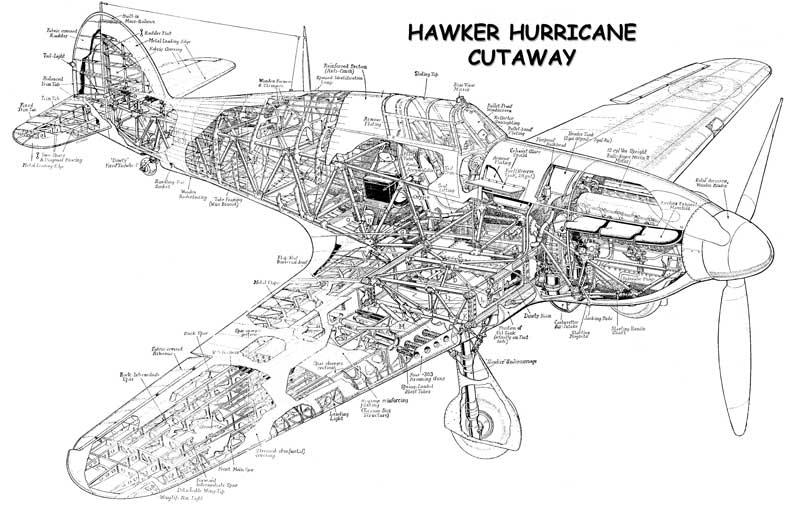 |
This fabulous Hurricane cutaway comes in full size 8.5x11 PDF for FREE included in your MyModels folder! |
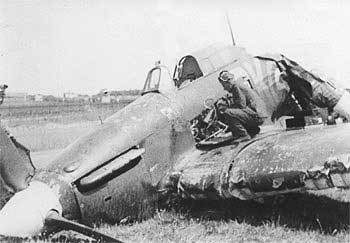 |
July 7, 1941. Hawker Hurricane I P2827 PK-K. Pilot J. Czerniak. Undershot the runway at Speke. Pilot safe, aircraft written off. |


